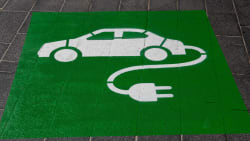Tire Safety For Angelenos

Tires in Los Angeles - What To Keep In Mind
Your tires take a beating even if you drive like a saint. Yet few give much thought to making sure their tires are in good condition and working properly.
By The Editors
Wed, Aug 24, 2022 09:20 PM PST
As always, you should consult a professional when dealing with your car - especially when it comes to something as important as its tires.
If you're a diver in the city of Los Angeles, CA, then you're likely already aware of the many dangers that come with driving on our roads. From potholes to glass shards and everything in between, it's important to be extra careful when behind the wheel. But one hazard you may not have considered is the condition of your tires.
Driving in LA, there are a lot of things to look out for. The heat, the rare but significant downpours, the condition of the roads, the traffic. These are all things that you should consider when buying and caring for tires in LA.
Driving Conditions In L.A. And How They Affect Your Tires
The Heat
When it comes to the heat in Los Angeles, it can be a major factor when it comes to your car tires. The high temperatures can cause the rubber on your tires to wear down faster, and it can also cause them to overheat. This can lead to a number of problems, such as a blowout or even a fire. It's important to be aware of the dangers of the heat and take steps to protect your tires.
One way to protect your tires from the heat is to make sure they are properly inflated. Overinflated tires can burst, and underinflated tires can overheat. Another way to protect your tires is to park in a garage or covered parking lot whenever possible. This will help keep your tires out of direct sunlight, off the hot tarmac, and help them last longer.
The Condition Of The Roads
Los Angeles is notorious for its traffic, but the condition of the roads can also be a factor in tire wear. Potholes, cracks, and uneven pavement can all cause damage to your tires. If you hit a pothole, you may need to have your tires inspected for damage. And if you regularly drive on rough roads, you may need to replace your tires more often.
To help protect your tires from the condition of the roads, you can of course try to avoid driving over potholes and other obstacles. And again, you should make sure your tires are properly inflated. Soft tires are more likely to be damaged by potholes and other road hazards.
The Traffic
L.A. is known for its traffic, and it can be a major factor in tire wear. If you're constantly stopping and starting in traffic, your tires can wear down faster. We could say something like "To help protect your tires from the effects of traffic, you can try to avoid stop-and-go traffic whenever possible"... But, this is L.A.
Again, you should also make sure your tires are properly inflated. Soft tires are more likely to be worn down by the constant stopping and starting. Notice a pattern here? Check the air pressure in all four tires regularly!

It Never Rains... Until It Pours
In L.A., we are accustomed to long dry spells, but when the rain finally comes, it can be a major event. The rain can cause problems for drivers in a number of ways. It can make the roads slippery and dangerous, and it can also damage your car tires.
If you're driving in the rain, you need to take precautions. Make sure your tires are properly inflated (got it?) and that you have good tread on your tires. Drive slowly and carefully, and use caution when braking or turning. If possible, try to avoid driving in the rain altogether. All-season tires like Hercules StrongGuard H-RD (for trailers) or Michelin Pilot Sport All Season 4 (for personal vehicles) are great options for LA weather.
If you must drive in the rain, take these precautions to help keep yourself and your passengers safe:
- Make sure your windshield wipers are working properly and that your windshield washer fluid is full.
- Slow down and drive cautiously. Avoid sudden movements that could cause you to lose control of your car.
- Use caution when braking or turning; L.A. roads are very slippery when wet due to the build-up of oil and goop from the long periods of no rain.
You could try driving with summer tires in the hotter months and then switching to all-season tires when the weather cools down and rain is more likely.
Road Trips To The Mountains
What about when you decide to go up into the mountains near L.A. to go camping or skiing?
When you're driving in the mountains, you need to take extra precautions with your car tires. The altitude and the colder temperatures can be hard on your tires.
First of all, make sure your tires are properly inflated (duh!). You should also make sure your tires have good tread and are in good condition. Tires that have worked fine on L.A. freeways for years will probably not do well in mud and snow... So, you'll want to drive slowly and carefully. Take it easy on the brakes and don't make any sudden turns. Roads can be slippery when it's cold, so use caution when driving.
Driving in snow requires a totally different strategy to driving in dry, clear conditions. If you're driving in the mountains and it starts to snow, pull over and wait it out if possible. Remember, it's better to arrive late than not at all.
Be prepared for anything. Make sure your car is in good condition and that you know how to handle it in different conditions.

General Tire Care Tips
L.A. driving conditions can be extreme, and this can put your tires and your driving ability to the test. Here are a few tips to keep your tires in good shape so that you can navigate anything the L.A. roads decide to throw at you.
1. Check Your Tread Depth Regularly
One of the most important things you can do for your tires is to regularly check the tread depth. The tread is what provides traction and helps you stop, so it's important to make sure it's not worn down too much.
There are a few ways to check your tread depth. One is to use a penny. Place the penny upside down in the tread groove with Lincoln's head facing down. If you can see all of Lincoln's head, then your tread depth is less than 2/32nds of an inch and it's time for new tires.
Another way to check tread depth is to look for the tire wear bars. These are raised portions of the tire that indicate when the tread has reached a certain point. If you see these, it means you only have about 1/16th of an inch of tread left and new tires are needed.
2. Inspect for Damage Regularly
In addition to checking tread depth, it's also important to regularly inspect your tires for any damage. Look for things like cuts, cracks, or bulges in the sidewall. These can all be signs of serious problems that need to be addressed. If you see any damage, it's important to have the tire inspected by a professional as soon as possible. They'll be able to tell you if the tire can be repaired or if it needs to be replaced.
3. Rotate Your Tires Regularly
Another important thing to do is to rotate your tires on a regular basis. This helps evenly distribute the wear and tear so they'll last longer. Most experts recommend having your tires rotated every 5,000 to 8,000 miles. But it's a good idea to check your owner's manual or with a professional to be sure.
4. Keep Your Tires Properly Inflated
One of the best things you can do for your car tires is to keep them properly inflated. This helps improve gas mileage and prolongs the life of the tires.
It's easy to check your tire pressure at home with a simple gauge. Just make sure to check when the tires are cold for the most accurate reading. You can find the recommended pressure for your tires in the owner's manual or on a sticker inside the driver's door.
5. Don't Ignore Warning Signs
If you start to notice any problems with your car tires, don't ignore them! It's important to have the tires inspected by a professional as soon as possible. Ignoring problem signs can lead to serious issues down the road, so it's always better to be safe than sorry.
The Bottom Line
When it comes to tires, there are a lot of things to consider. The climate, the type of driving we do, and the size of our car all play a role in what type of tire we should buy. In Los Angeles, we need tires that can handle the heat and the rain, and that are designed for hot weather climates, or, if you do a lot of driving in the mountains: all-season tires that can handle both wet and dry conditions.
Make sure your car is in good condition and carry a spare tire and some tools so you're ready for anything. Be sure to check your tires regularly and don't hesitate to have them inspected by a professional if you have any concerns.
By following these simple tips, you can help keep your car tires in good condition and improve your safety on the roads.
Again, check your tire pressure!
Photo credits: Freddy G (featured image), Benjamin Brunner, and Blake Carpenter.





